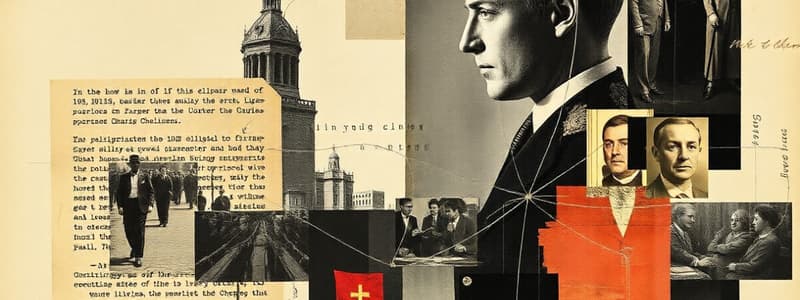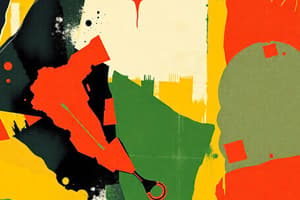Podcast
Questions and Answers
What is the primary focus of historical criticism?
What is the primary focus of historical criticism?
- The chronological order of historical events
- The origins and circumstances of historical texts (correct)
- The personal opinions of historical authors
- The aesthetic qualities of historical texts
Why is it important to check the authenticity of historical texts?
Why is it important to check the authenticity of historical texts?
- To avoid wasting effort, time, and money (correct)
- To accept all historical claims as true
- To ensure the effectiveness of historical narratives
- To determine the popularity of historical events
Which of the following is NOT an objective of this module?
Which of the following is NOT an objective of this module?
- Distinguish the nature of historical criticism
- Examine the moral implications of historical events (correct)
- Critique the credibility of historical texts
- Appreciate the value of authenticity in historical sources
What can be a parallel drawn between online shopping and historical research?
What can be a parallel drawn between online shopping and historical research?
How does examining the underlying circumstances of a historical text benefit a researcher?
How does examining the underlying circumstances of a historical text benefit a researcher?
Which statement best summarizes the lesson objectives?
Which statement best summarizes the lesson objectives?
What could be a consequence of not critiquing historical texts?
What could be a consequence of not critiquing historical texts?
Which activity is suggested to help understand historical authenticity?
Which activity is suggested to help understand historical authenticity?
What is one of the primary goals of historical criticism?
What is one of the primary goals of historical criticism?
What does external criticism primarily focus on?
What does external criticism primarily focus on?
Which of the following is a method used in external criticism?
Which of the following is a method used in external criticism?
What aspect does internal criticism evaluate?
What aspect does internal criticism evaluate?
Which of the following tests would help determine the authenticity of a historical document?
Which of the following tests would help determine the authenticity of a historical document?
What does provenance refer to in historical criticism?
What does provenance refer to in historical criticism?
What is NOT a part of the tests of authenticity in historical criticism?
What is NOT a part of the tests of authenticity in historical criticism?
What does source criticism analyze in the context of historical criticism?
What does source criticism analyze in the context of historical criticism?
Flashcards
Historical Criticism
Historical Criticism
Examining the origins and circumstances surrounding a historical text to understand its context and trustworthiness.
Authenticity
Authenticity
The quality of being genuine and true to its purported origins.
Credibility
Credibility
The trustworthiness and reliability of a historical source.
Historical Text
Historical Text
Signup and view all the flashcards
Checking Historical Sources
Checking Historical Sources
Signup and view all the flashcards
Bias in Sources
Bias in Sources
Signup and view all the flashcards
Context of a Text
Context of a Text
Signup and view all the flashcards
Checking Credibility and Authenticity
Checking Credibility and Authenticity
Signup and view all the flashcards
Historical Criticism
Historical Criticism
Signup and view all the flashcards
Provenance of a Source
Provenance of a Source
Signup and view all the flashcards
External Criticism
External Criticism
Signup and view all the flashcards
Internal Criticism
Internal Criticism
Signup and view all the flashcards
Authenticity
Authenticity
Signup and view all the flashcards
Higher Criticism
Higher Criticism
Signup and view all the flashcards
Source Criticism
Source Criticism
Signup and view all the flashcards
Anachronistic
Anachronistic
Signup and view all the flashcards
Study Notes
Module 1: Lesson Three - Historical Criticism
- Objectives: Students should learn to distinguish historical criticism, critique historical text credibility and authenticity, and appreciate the value of checking credibility and authenticity.
Introduction
- This lesson builds on the previous module on historical sources.
- It discusses how to assess the credibility of historical sources.
Activity: Authenticity Check
- Abigail needs authentic products due to a lockdown.
- This is an exercise to learn how to critique information from the internet.
- Online shopping can have issues with fake products.
- It's important to check for authenticity.
Analysis
- Checking products or information from social media is important.
- Online information can be unreliable, and proper inspection is crucial.
Historical Criticism - Abstraction
- Historical criticism examines the genesis of early texts to understand context.
- Two primary goals of historical criticism: discover the initial meaning and reconstruct the historical context surrounding a text.
- Two parts of Historical Criticism:
- Provenance/Source: Determining if a source is authentic.
- Higher Criticism: Weighing the testimony of a source to know the truth.
Types of Historical Criticism
- External criticism:
- Assesses source authenticity to find forgeries, fabrications or misrepresentations.
- It evaluates through methods like
- Paleography (deciphering and dating manuscripts)
- Diplomatics (understanding how a document came to be)
Tests of Authenticity
- Determining Authenticity:
- Dates/Time Periods, is a document's date believable in its context?
- Author: Is the author credible? Are their statements consistent?
- Style: Analyze language, writing style, etc. Are those characteristics consistent with the author/time period?
- Anachronisms (things out of time): look for references to people, events, or objects that aren't possible at the date of the document.
Internal Criticism
- Determining credibility: Assess the credibility of factual claims and details within a document without checking its authenticity.
- Tests of Credibility:
- Author Identification: Who is the author, and what is their reputation/background?
- Date Determination: When was the document written?
- Truthfulness: Is the document consistent with other reliable sources?
Historical Criticism Methodologies
- Five methods of historical criticism:
- Source Criticism: Analyse the source material by historians
- Form Criticism: identify an original form or historical context
- Redaction Criticism: examine an author's editing of sources
- Tradition Criticism: trace the development of traditions
- Canonical Criticism: interpret the text through understanding the canon itself
Application
- Apply these methods to evaluate the authenticity and credibility of historical sources.
- Focus specifically on the first mass event.
Studying That Suits You
Use AI to generate personalized quizzes and flashcards to suit your learning preferences.




